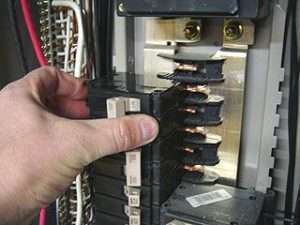The Truth Behind Aluminum Wiring

We inspected 3 houses in the Tamarac, FL area and the buyer was not happy when we kept finding aluminum wiring in each of the homes.

If you didn’t know, the chances of getting a home with aluminum branch wiring insured in South Florida is pretty low. Multi-strand aluminum wiring may make it. There is a lot of conversation surrounding the history of aluminum wiring in homes. “Is it safe? Should it be replaced?” Maybe, but it is not likely that a home in South Florida will be insurable.
When performing a home inspection or a 4 point inspection I will inform the client if the presence of aluminum wiring is identified. One of the 4 point form items is the section for marking to indicate the presence of aluminum wiring.

So though the aluminum wiring is not unsafe just because it is installed, it is considered a hazard because the aluminum wire is more likely to cause a fire than copper wire for many reasons: Aluminum is softer than copper, which makes it more likely to cause breaks in the wire, creating hot spots. The oxide that forms on aluminum causes overheating, while the oxide that forms on copper does not.
Aluminum wiring problems
Some of the problems with aluminum wiring things you may be hearing about aluminum wiring are not true. It has not been recalled and it has not not approved in homes. It is permitted with the correct installation methods and materials. Electrical wiring in homes was traditionally copper since the introduction of electricity into homes in the late 19th century. Aluminum wiring was introduced to homes in North America in the mid-1960s. The price of copper was very high, and aluminum was cost-effective.
– The Issues
- Flickering lights
- Warm cover plates on switches and receptacles
- Burned insulation on wiring
- Overheating issue
After these issues were discovered shortly after aluminum was introduced they found that there were 3 primary differences between aluminum and copper.
- Softness – aluminum is a much softer metal. Electricians had to be more careful during installation to ensure they didn’t damage the wire and create hot spots that result in overheating
- Creeping – aluminum wiring expands more when electricity flowed through it. Over time, this expansion and contraction would over time loosen the wiring and creep out of the circuit breakers causing a loose connection and overheating.
- Rusting – when aluminum wiring rusts, the white oxide is not a good conductor and it does interfere with the flow of electricity and again, can cause overheating.
Is aluminum wiring a deal-breaker, a common problem with aluminum wiring found during real estate transactions
aluminum electrical wiring isn’t a deal-breaker. The problem was at the connections for receptacles, light fixtures, appliances, and at the panel. The solution has been special connectors. They are:
- Small receptacles marked CO/ALR or AL-CU
- Large receptacles (> 20 amps) marked AL-CU or CU-AL
- Switches marked CO/ALR
- Twist-on wire connectors (sometimes called wire nuts) marked AL-CU or CU-AL
Electrical panels and breakers marked AL-CU or CU-AL were also available.
Some Facts and Figures: Aluminum Building Wiring
- On April 28, 1974, two people were killed in a house fire in Hampton Bays, New York. Fire officials determined that the fire was caused by a faulty aluminum wire connection at an outlet.
- According to the Consumer Product Safety Commission (CPSC), “Homes wired with aluminum wire manufactured before 1972 [‘old technology’ aluminum wire] are 55 times more likely to have one or more connections reach “Fire Hazard Conditions” than is a home wired with copper.”
How do you inspect for aluminum wiring?
Identifying Aluminum Wiring
- Aluminum wires are the color of aluminum and are easily discernible from copper and other metals.
- Since the early 1970s, wiring-device binding terminals for use with aluminum wire have been marked CO/ALR, which stands for “copper/aluminum revised.”
- Look for the word “aluminum” or the initials “AL” on the plastic wire jacket. Where wiring is visible, such as in the attic or electrical panel, inspectors can look for printed or embossed letters on the plastic wire jacket. Aluminum wire may have the word “aluminum,” or a specific brand name, such as “Kaiser Aluminum,” marked on the wire jacket. Where labels are hard to read, a light can be shined along the length of the wire.
- When was the house built? Homes built or expanded between 1965 and 1973 are more likely to have aluminum wiring than houses built before or after those years.
Aluminum wiring repair

A qualified electrician who is experienced in evaluating aluminum wiring should be contacted to inspect the home’s electrical wiring. The CPSC recommends the following for correction:
- Rewire the home with copper wiring. In Florida, this is the most likely option to ensure the home can be insured but also expensive to complete.
- Use copalum crimps. The crimp connector repair consists of attaching a piece of copper wire to the existing aluminum wire branch circuit with a specially designed metal sleeve and powered crimping tool. This special connector can be properly installed only with the matching AMP tool. An insulating sleeve is placed around the crimp connector to complete the repair. Although effective, they are expensive (typically around $50 per outlet, switch, or light fixture)
I hope this information has been helpful in explaining the truths behind aluminum wiring. Though there are mitigation actions in place I’m a fan of re-wiring the home just to have peace of mind. If you have additional questions and want to get in contact with GGR Home Inspections please send us a note, text, or call.







Pingback: Shop for a Home with these 4 Major Components in Mind - GGR Home Inspections